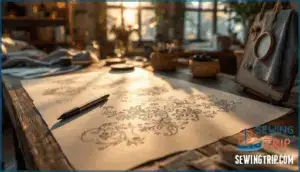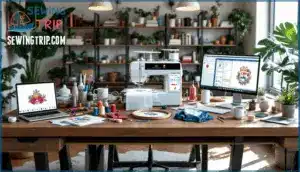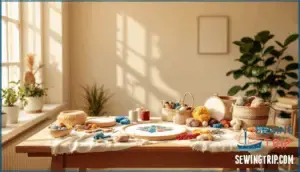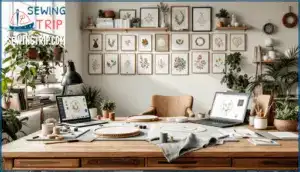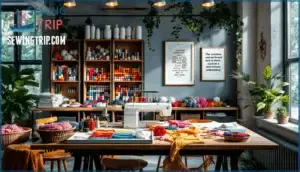This site is supported by our readers. We may earn a commission, at no cost to you, if you purchase through links.
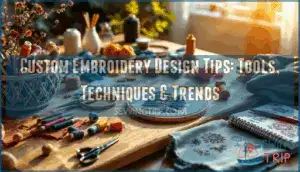 Your first embroidered design doesn’t need to be perfect—it just needs to start somewhere, even if that’s a simple shape traced onto fabric with a water-soluble pen. The real turning point happens when you understand which tools transform rough ideas into stitchable patterns, how thread choices can make or break visibility, and why some designs translate beautifully to fabric while others fall apart under the needle.
Your first embroidered design doesn’t need to be perfect—it just needs to start somewhere, even if that’s a simple shape traced onto fabric with a water-soluble pen. The real turning point happens when you understand which tools transform rough ideas into stitchable patterns, how thread choices can make or break visibility, and why some designs translate beautifully to fabric while others fall apart under the needle.
Whether you’re digitizing artwork for a machine or mapping out hand-stitched motifs, these custom embroidery design tips will help you avoid common pitfalls and create pieces that look intentional, polished, and worth the time you put into them.
Table Of Contents
Key Takeaways
- Success in embroidery comes from choosing the right tools for your skill level—beginners should start with user-friendly platforms like Canva or Printful Design Maker, while advanced creators can leverage Photoshop for full creative control.
- Bold, simple shapes with thick lines (2mm+) and minimal text (5mm+ letter heights) translate beautifully to embroidered fabric, while intricate details, thin strokes, and small fonts collapse under the needle and should be avoided.
- Thread density between 0.3–0.5mm paired with proper stabilizer choice prevents puckering and ensures durability, while sustainable recycled threads now deliver the same performance as virgin materials without compromising quality.
- Blending hand and machine embroidery methods creates hybrid pieces that combine the speed and consistency of automation with the artistic depth and texture that only hand-stitching can provide.
Essential Tools for Custom Embroidery Design
You’ll need the right mix of tools and materials to bring your embroidery ideas to life. Whether you lean toward digital platforms or prefer hands-on methods, each approach has its own strengths.
Let’s break down what’s available so you can pick what works best for your creative process.
Digital Design Platforms (Canva, Photoshop, Printful Design Maker)

When you’re ready to break free from hand-drawn limitations and scale your embroidery vision, digital design platforms become your creative launchpad. Each tool offers different strengths:
- Canva makes pattern creation accessible for beginners with drag-and-drop simplicity
- Photoshop unlocks sophisticated vector graphics control for experienced designers
- Printful Design Maker lets you preview embroidered designs directly on garments—for free
Traditional Drawing Methods (trace Paper, Water-soluble Pen)
But sometimes the most rebellious move is to unplug from the screen entirely—traditional drawing methods like trace paper and water-soluble pens put your raw creativity directly onto fabric without a single pixel in between.
Freehand sketching with a water-soluble pen lets confident designers draw embroidery patterns straight onto canvas, while trace paper offers a forgiving middle ground for pencil marks and ink transfers before committing to the final piece.
Materials Needed (fabric, Thread, Needles, Stabilizer, Hoop)
Once you’ve nailed down your design approach, you’ll need the right materials—fabric, thread, needles, stabilizer, and a hoop—to turn that vision into something you can actually wear or hang on a wall.
Fabric selection sets your foundation, while embroidery thread in rayon or polyester delivers that signature sheen.
Sharp needles paired with proper stabilizer choice prevent puckering on stretch materials, and hoop sizes keep everything taut during stitching—whether you’re using an embroidery machine or mastering embroidery techniques by hand.
Choosing The Right Tool for Your Skill Level
Your skill level—whether you’re picking up a needle for the first time or you’ve been digitizing designs for years—should guide which tool you grab. Here’s a quick skill assessment and tool comparison:
- Beginners: Start with Design Maker platforms like Canva or Printful—user-friendly embroidery design software with beginner tips built in.
- Intermediate: Experiment with digitized design software that balances embroidery techniques and trends with sophisticated features.
- Advanced: Access Photoshop’s power for embroidery machine and software workflows demanding total creative control.
Designing Patterns for Embroidery Success
A great embroidery design doesn’t just look good on paper—it needs to translate well to thread and fabric. The difference between a pattern that stitches smoothly and one that falls apart often comes down to how you manage shapes, spacing, and detail from the start.
Here’s what you need to keep in mind when designing patterns that actually work.
Creating Clear, Bold Shapes and Lines
Think of embroidery like building with blocks—your design needs strong foundations, not intricate details that collapse under thread. Bold typography and geometric patterns translate beautifully when you simplify shapes and increase line thickness. Vector graphics give you clean edges, while shape simplification guarantees your design creation doesn’t get lost in translation.
| Design Element | Avoid | Embrace |
|---|---|---|
| Line Thickness | Hairline strokes under 1mm | Bold outlines 2mm+ |
| Typography | Delicate serifs, script fonts | Sans-serif, block letters |
| Shapes | Gradient fills, photo textures | Solid colors, clean vectors |
| Patterns | Intricate filigree details | Strong geometric forms |
Avoiding Small Text and Thin Details
Small text crumbles where bold letters stand tall—embroidery demands legibility, not microscopic flourishes that vanish beneath the needle’s path. Typography and font choices matter when stitch density can’t replicate what your screen shows. Detail simplification isn’t compromise—it’s clarity.
Visibility tips for custom embroidery keep your graphic design for embroidery readable, while font size guidelines protect your work from thread chaos.
- Set minimum letter heights at 5mm to prevent embroidery thread and color from blurring into illegible mush
- Eliminate hairline strokes under 1mm where legibility factors meet stitch density limitations head-on
- Test your design at actual size before committing—what looks sharp digitally often fails physically
- Replace intricate fonts with bold alternatives that honor embroidery design principles over aesthetic stubbornness
Incorporating Negative Space and Solid Fills
Negative space isn’t empty—it’s breathing room that stops your design from suffocating under thread buildup, and solid fills ensure fabric doesn’t peek through like an uninvited guest.
Visual balance demands you treat empty shapes with intention, filling areas completely so your custom embroidery stands bold against the base material.
Master this contrast—where filled areas assert themselves and negative space amplifies impact—and you’ll achieve graphic design for embroidery that seizes focus without apology.
Embroidery demands contrast—let filled areas command attention while negative space amplifies their power
Redesigning Photos and Complex Graphics for Embroidery
Photos can’t translate to thread without a radical transformation—pixels demand conversion to solid, stitch-friendly shapes before any needle touches fabric. Vector conversion and graphic simplification strip away gradients and detail overload, letting embroidery software interpret your design maker files as stitch-ready geometry.
Image editing becomes design adaptation: you’ll refine pixels into bold forms that digital embroidery techniques can execute, turning complex graphics into custom embroidery that draws focus instead of collapsing under thread.
Optimizing Color and Thread Choices
The right color and thread decisions can make or break your embroidery project. Your choices affect how your design looks, how long it lasts, and even how much it costs to produce.
Here’s what you need to know to select colors and threads that deliver professional results every time.
Selecting a Limited Vs. Unlimited Color Palette
Color decisions in embroidery aren’t just aesthetic—they’re strategic choices that can make or break your design’s impact. A limited color palette creates minimalist visual balance and simplifies thread limitations, while unlimited color embroidery unlocks gradients and complex design constraints.
Your palette selection shapes production costs, color harmony, and overall legibility—so choose based on your custom embroidery vision, not trends alone.
Matching Thread Colors for Visibility and Style
Thread color isn’t just decoration—it’s the difference between a design that pops off the fabric and one that disappears into it. Here’s how to nail your thread selection every time:
- Contrast is king—choose embroidery thread colors that stand apart from your fabric to guarantee visibility tips translate into real-world impact
- Test color theory in natural light—what looks bold on-screen can fade under real conditions, so validate your palette choices physically
- Match thread colors to brand personality—your custom embroidery should reinforce style guidance, not fight it
Considering Thread Density and Stability
Once you’ve locked in your thread colors, it’s time to look under the hood—because how densely you pack those stitches determines whether your design holds up or falls apart after the first wash. Thread density between 0.3–0.5 mm keeps stitch stability rock-solid without overwhelming your fabric selection.
Master density control through proper thread tension and embroidery optimization—your machine embroidery deserves these embroidery techniques for lasting embroidery design tips that won’t compromise thread colors.
Using Sustainable and Durable Threads
Beyond stability, sustainable materials like recycled yarns bring both durability and conscience to custom embroidery. Eco-friendly threads made from recycled polyester—think green embroidery with durable fibers—deliver tear resistance equal to virgin threads while cutting textile waste.
Brands offering eco-friendly products with GRS certification prove sustainability doesn’t sacrifice performance, making embroidery thread choices that honor both craft longevity and the planet smarter than ever. By using recycled sewing threads, designers can markedly reduce environmental impact.
Tips for Transferring and Digitizing Designs
Getting your design from paper to fabric—or from sketch to stitch file—doesn’t have to feel like decoding ancient runes. Whether you’re tracing by hand or letting software do the heavy lifting, the right transfer method can save you hours of frustration.
Here’s how to bridge the gap between your creative vision and the final embroidered piece.
Using Carbon Transfer Paper and Tracing Techniques
Carbon transfer paper works like a blueprint for your fabric, letting you trace designs with precision and skip the freehand stress entirely. Place your chosen transfer paper between your printed design and fabric, secure it with tape, then trace firmly with a ballpoint pen or stylus. The pressure transfers the pattern cleanly, giving you sharp guidelines to stitch over without second-guessing your placement.
Why carbon transfer paper unlocks creative freedom:
- No artistic talent required – You can transform any printed design into stitchable art
- Repositionable until committed – Test placement before making permanent marks on your fabric
- Clean lines mean confident stitching – Clear guidelines eliminate guesswork and messy rework
- Works on nearly any fabric weight – From delicate silk to heavy canvas, you’re covered
- Affordable experimentation – Test bold ideas without expensive digitizing software or equipment
Direct Drawing on Fabric for Confident Designers
If you trust your artistic hand and want complete creative control, skip the transfer paper and draw your design directly onto fabric with a water-soluble pen. This freehand technique lets you adjust embroidery patterns on the fly, perfect for custom embroidery where spontaneity matters.
Your needle control improves as you follow your hand-guided marks, and design creation becomes instinctive—no tracing, just pure direct stitches that reflect your vision.
Digitizing Artwork for Embroidery Machines
Turning your artwork into machine-ready embroidery files requires specialized software that converts flat images into stitch commands—a process called digitizing that maps out every needle movement, thread color change, and stitch direction.
Here’s what digitizing software handles for digital embroidery:
- Vector conversion transforms your design creation into clean paths the embroidery machine can read
- Thread mapping assigns specific colors and densities for stitch optimization
- Image editing refines details so your digitized design translates beautifully onto fabric
Mastering this workflow unlocks repeatable, professional-quality embroidery design.
AI-powered Digitizing Tools and Workflow Efficiency
AI-powered digitizing tools can slash your manual editing time by up to 50%, letting you skip tedious stitch-by-stitch adjustments and focus on what actually matters—bringing your vision to life.
These platforms use workflow automation to analyze thread density, enhance stitch paths, and simplify complex shapes automatically.
You’ll turn design creation into a smooth process, transforming custom embroidery from a painstaking craft into an efficient production system that scales with your ambitions.
Current Trends and Advanced Embroidery Techniques
Embroidery keeps evolving, and the latest trends are pushing boundaries in exciting ways. From abstract experimentation to smart branding strategies, today’s techniques blend tradition with innovation.
Here’s what’s shaping the craft right now and how you can use these approaches in your own work.
Abstract and Culturally-inspired Embroidery Styles
Embroidery design is breaking free from tradition, embracing both Cultural Fusion and bold Abstract Motifs that challenge the old rulebook. You’re witnessing a revolution where heritage meets innovation, giving your work fresh creative power.
Here are the key trends shaping the embroidery landscape:
- Abstract embroidery accounted for 27% of custom design submissions in 2024, proving that geometric shapes and organic lines resonate with modern audiences.
- Traditional styles like Indian zari and Japanese sashiko surged 29% in commercial reinterpretations, showing how Embroidery Heritage fuels contemporary expression.
- Fusion embroidery combining multiple cultural motifs grew 35% among textile startups, opening doors for cross-cultural storytelling through Digital Embellishments.
- Sustainable Threads using organic cotton and recycled polyester hit 45% usage in cultural embroidery, aligning your craft with eco-conscious values.
These Cultural Embroidery Techniques and Abstract Embroidery trends aren’t just aesthetic choices—they’re pathways to creating Embroidery Patterns that stand out. Your Embroidery Design can honor tradition while pushing boundaries, using modern Embroidery Techniques And Trends to craft pieces that truly matter. The use of contemporary designs is becoming increasingly popular in the embroidery world.
Combining Hand and Machine Embroidery Methods
You don’t have to choose between the warmth of hand-stitching and the speed of a machine—blending both methods gives you the best of control and efficiency in one powerful workflow.
Hybrid Stitching and Fusion Techniques let you machine-embroider your base layers, then add intricate hand embroidery accents for depth. This embroidery blending approach is revolutionizing custom embroidery, giving your embroidery designs soul alongside precision.
| Method | Best Use | Creative Impact |
|---|---|---|
| Machine Embroidery base | Large fills, logos | Speed meets consistency |
| Hand Embroidery details | Texture, final touches | Artistic authenticity |
| Mixed Media layering | Complex custom pieces | Unforgettable originality |
Modern Design Trends in Custom Apparel Decoration
Digital printing is merging with embroidery, creating hybrid embroidery effects that bring photo-realistic depth to custom apparel decoration. Textured fabrics layered with eco-friendly threads and sustainable materials are reshaping fashion and apparel design.
Geometric shapes and bold 3D elements now dominate, while personalization powered by real-time mockups slashes turnaround time.
These embroidery techniques and trends prove custom embroidery is no longer just decoration—it’s visual rebellion with embroidery design at the core.
Enhancing Logos and Branding With Embroidery
Logos stitched into fabric don’t just sit on a collar—they become tactile proof of quality, turning every garment into a walking billboard that customers actually want to wear. Elevating logos with embroidery transforms brand identity into something permanent and professional.
Here’s how custom embroidery strengthens branding:
- Logo stitching outlasts printed designs, surviving hundreds of washes without fading
- Embroidery fonts add dimension that flat printing can’t match
- Custom patches let you pivot branding across corporate apparel without redesigning everything
- Thread choices make logo design pop or blend, depending on your vision
Frequently Asked Questions (FAQs)
How do I price custom embroidery services?
Machine time dictates everything—most embroidery services charge $50 to $00 per thousand stitches.
Factor in thread costs, design complexity, garment markup, and your target profit margins.
Research local competitors’ pricing, then quote customers based on design specifications and production time.
Whats the best fabric for embroidery beginners?
Start with cotton or linen—they’re forgiving, stable, and won’t fight back while you’re learning the ropes.
These fabric types offer excellent stitch stability and work beautifully with most embroidery thread, letting you focus on mastering textile craft and sewing techniques without wrestling your canvas.
How long does machine embroidery typically take?
Depending on design complexity, a simple logo might take just 10-15 minutes, while intricate patterns can run 45 minutes or longer.
Stitch time varies with embroidery speed settings, thread consumption, and fabric impact on production efficiency during the embroidery process.
Can I wash embroidered garments safely?
Treat your embroidered pieces like treasured heirlooms—they’ll last if you manage them right.
Always turn custom embroidery garments inside out, wash on gentle settings with cold water, and air dry flat to preserve embroidery techniques and guarantee durability and longevity of embroidery on fabric decoration.
What causes thread breaks during machine stitching?
Common culprits include improper thread tension, incorrect needle size, excessive stitch length, fabric stretch during the embroidery process, and poor machine calibration.
Damaged needles or low-quality thread colors also disrupt machine embroidery techniques.
Conclusion
The devil’s in the details, but mastery lives in the execution. Once you’ve chosen your tools, mapped your color palette, and transferred your design with confidence, the thread becomes your language—one stitch at a time.
These custom embroidery design tips aren’t just guidelines; they’re your foundation for turning fleeting ideas into textile statements that demand attention. So grab your hoop, trust your instincts, and remember: every expert was once a beginner who refused to settle for mediocre work.
- https://artcentron.com/2022/09/06/tips-for-creating-custom-embroidery-designs/
- https://www.megridigitizing.com/embroidery-digitizing-future/
- https://www.marketreportanalytics.com/reports/embroidery-digitizing-software-74335
- https://www.printful.com/blog/custom-embroidery-trend
- https://coldesi.com/embroidery/2025-commercial-embroidery-trends-shaping-the-future-of-the-industry/

